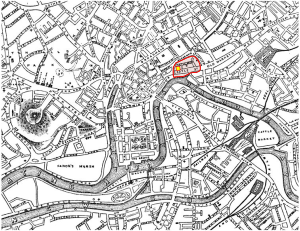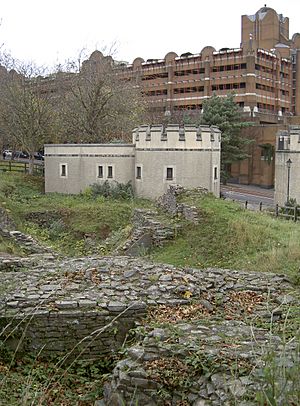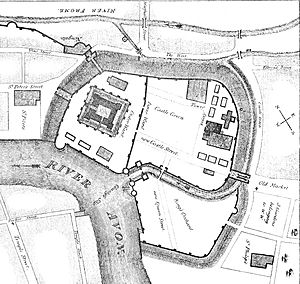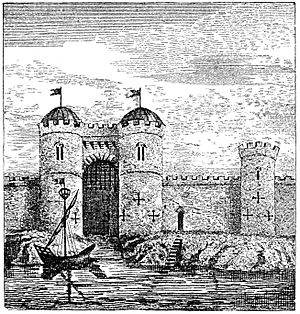Bristol Castle facts for kids
Quick facts for kids Bristol Castle |
|
|---|---|
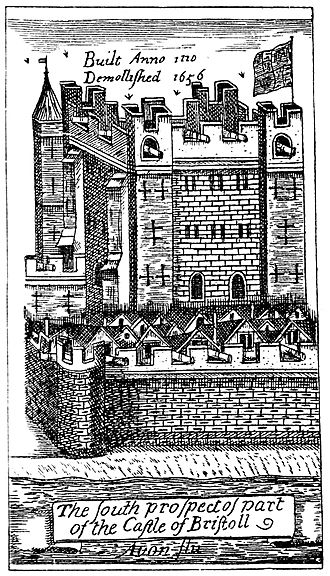
Bristol Castle viewed from the River Avon. Detail from James Millerd's map of Bristol, 1673
|
|
| General information | |
| Town or city | Bristol |
| Country | England |
| Coordinates | 51°27′21.4″N 2°35′17.51″W / 51.455944°N 2.5881972°W |
| Client | William the Conqueror |
| Design and construction | |
| Architect | Robert, 1st Earl of Gloucester |
Bristol Castle was a strong Norman castle built to protect the city of Bristol. Today, you can still see parts of it in Castle Park, which is close to the Broadmead Shopping Centre. One part you can see is the sally port, which was a secret exit.
Contents
Why Was Bristol Castle Built Here?
Bristol Castle was built in a very smart spot. It was on the eastern side of the old walled town. The River Avon was to the south, and the River Frome was to the north.
These rivers were connected by a canal. This canal formed a moat around the eastern side of the castle. Because the town of Bristol was also built where these two rivers met, the castle and town were completely surrounded by water. This made them very hard to attack!
Who Built Bristol Castle?
The first castle in Bristol was a wooden motte and bailey castle. This means it had a large mound (motte) with a tower on top, and a walled courtyard (bailey) below. It was likely built by William the Conqueror himself. He kept Bristol as a royal property.
One of William's friends, Geoffrey de Montbray, a bishop, seemed to be in charge of the castle for the king. Records from 1088 show that Geoffrey used the castle when he rebelled against King William II.
The Castle Changes Hands
After William II won, the lands of the rebels were given to his loyal supporters. Robert FitzHamon received a large area, including Bristol Castle. His daughter, Mabel FitzHamon, married Robert, 1st Earl of Gloucester. He was the illegitimate son of King Henry I.
When Mabel's father died in 1107, she brought Bristol Castle to her husband. This is why he is known as "Robert of Gloucester."
Bristol Castle in the Civil War (The Anarchy)
Bristol Castle became very important during the civil wars that followed King Henry I's death. Henry's only son had drowned, so he named his daughter, Matilda, as his heir. However, her cousin, Stephen of Blois, took the throne when Henry died in 1135.
Matilda's half-brother, Robert of Gloucester, became her main commander. Rebels who supported Matilda gathered at his castle in Bristol.
Stephen Tries to Take the Castle
In 1138, King Stephen tried to attack Bristol. But he decided the town and castle were too strong to capture. A writer at the time said: "On one side of it, where it is considered more exposed to siege... a castle rising on a vast mound, strengthened by wall and battlements, towers and divers engines, prevents an enemy's approach."
When Stephen was captured in 1141, he was held prisoner in Bristol Castle. He was later exchanged for Robert of Gloucester, who had also been captured.
Royal Control of the Castle
The castle then passed to Robert's son, William. In 1173, William supported the rebellion of King Henry II's sons. After the rebellion failed, King Henry II took Bristol Castle for himself.
Bristol Castle became one of the most important royal castles in England. King Henry III, who grew up there, spent a lot of money improving it. He added a barbican (a fortified gatehouse) and a magnificent great hall. From 1224, Eleanor of Brittany was kept at the castle. She was confined but lived in comfort in the main tower.
Later, in 1283, the two young sons of Dafydd ap Gruffydd, the last princes of Gwynedd (Wales), were imprisoned in Bristol Castle for life.
The Castle's Decline and Destruction
By 1480, the castle was starting to show signs of neglect. When the historian John Leland visited around 1540, he noted that many towers were "on the point of collapse."
By the 1500s, the castle was not used much. The city leaders couldn't control this royal property, and the castle grounds became a place where lawbreakers could hide. In 1630, the city bought the castle.
When the Civil War began, Bristol supported the Parliament (the "Parliamentary" side). They tried to fix up the castle. However, the King's troops (the "Royalist" side) captured Bristol. After Parliament recaptured it in 1645, Oliver Cromwell ordered the castle to be destroyed.
Bristol Castle was demolished in 1656. However, one octagonal (eight-sided) tower survived until 1927. Some parts of the banqueting hall are still part of a building today, known as the Castle Vaults.
The castle moat was covered over in 1847, but it still exists underground. It flows under Castle Park and into the Floating Harbour. There's also a 16-meter-long secret tunnel that runs under the southwest part of the castle.
Bristol Castle Today
The area where the castle stood was later used for businesses. Much of it was destroyed during the 'Bristol Blitz' in World War II. After the war, it was turned into a public park called Castle Park.
The old vaulted rooms of the castle are now a Scheduled Ancient Monument. This means they are protected by law because of their historical importance.
Images for kids


